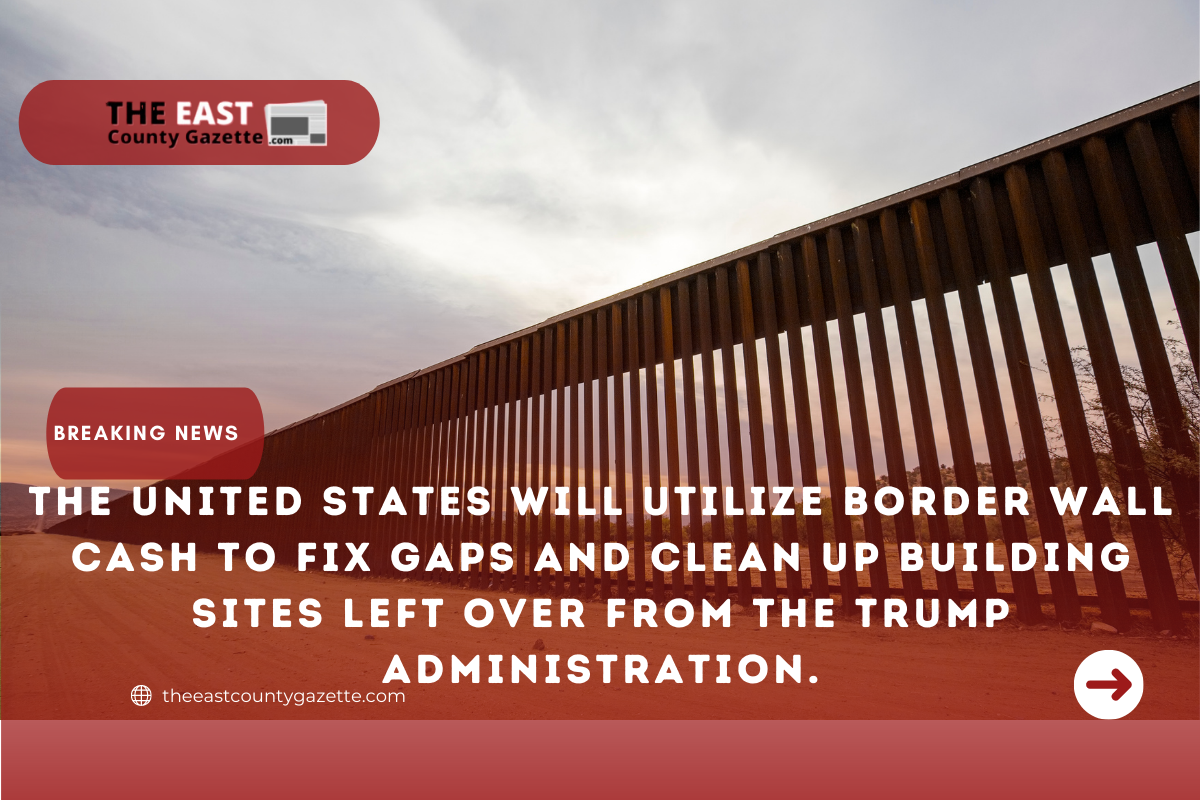US Will Utilize Border Wall Cash to Fix Gaps and Clean Up Building Sites Left Over From the Trump Administration
To close wall gaps and pay for environmental and clean-up projects in areas of Arizona, California, and Texas affected by the Trump administration’s barrier construction, the Department of Homeland Security (DHS) announced on Monday that it will use border security funding appropriated by Congress to close wall gaps and pay for such projects in areas affected by the Trump administration’s barrier construction.
The projects approved by Secretary of Homeland Security Alejandro Mayorkas include the installation of drainage to prevent flooding, the mitigation of soil erosion, the completion of roads used by Border Patrol agents, the demobilization of construction and equipment storage sites, and the disposal of unused materials and equipment.

Additionally, Mayorkas granted permission to U.S. Customs and Border Protection (CBP) to place barriers to seal “small” gaps along some wall sections that had been left open when construction was halted in January, stating that the measures were necessary to alleviate safety concerns.
“There will be many locations where barrier material will be employed,” a senior Customs and Border Protection official told CBS News on Tuesday.
The current barrier, such as an open, unsafe construction site, is being addressed, rather than adding additional mileage to the route, which would constitute the creation of a new barrier, according to the team.
The work will also entail the repair and completion of wall gates, such as those used by Border Patrol agents to rescue migrants who have become stranded in irrigation channels.
The CBP officer, who asked to remain anonymous in order to discuss the plans, stated that the total cost of the additional projects has not yet been calculated due to the completion of site inspections.
Several new construction and cleanup projects will be carried out along the U.S.-Mexico border in places where the Army Corps of Engineers has been tasked with assisting in the construction of former President Donald Trump’s border wall.
The Corps of Engineers is canceling wall building contracts so that the Department of Homeland Security can take over the operation of unfinished construction sites.
A broader Biden administration’s plan to wind down the mammoth Trump-era border wall construction operation, which has become one of the most expensive federal infrastructure projects in U.S. history, includes projects approved by Mayorkas, a member of the Democratic National Committee.
Having declared the construction of a border wall one of his primary political objectives, Mr. Trump was successful in securing $15 billion to fund it, the majority of which came from diverted military counter-narcotics and infrastructure funds.
His administration was ultimately responsible for the construction of more than 450 miles of border barriers, the majority of which replaced previous obstacles.
President Biden decried the border wall project as useless and wasteful when campaigning, and vowed that his government would not install “another foot” of barriers if elected.
Mr. Biden put a halt to border wall construction just hours after taking office, and he also declared a national emergency, which his predecessor had declared in order to redirect military monies.
Since then, his government has returned billions of dollars in abandoned Pentagon money, many of which were originally intended to be used to support expansion at military bases in the United States and abroad.
Mr. Biden’s campaign promise, however, is complicated by the fact that Congress has budgeted $6 billion for border barrier construction between fiscal years 2018 and 2021.
However, the Biden administration has encouraged Congress to revoke the unused funds but has stated that it will utilize the cash to “address urgent life, safety, and environmental issues emanating from the previous Administration’s wall construction” in the meanwhile.
Recently, the government said that it would use funds allocated by Congress to restore a flood levee system in Texas’ Rio Grande Valley and to mitigate soil erosion at a wall construction site in San Diego, among other things.
As part of the agreement, Mayorkas approved the repair of border barriers in San Diego in July.
Construction will take place within the Border Patrol sectors in San Diego, El Centro, California; Yuma, Tucson, Arizona; El Paso, and Texas. According to the Department of Homeland Security, work in El Paso, Tucson, and Yuma will focus on closing wall gaps, installing gates, and repairing barrier foundations.
Work on the new projects is slated to begin in the first quarter of 2022, with the Tucson sector serving as the starting point, according to CBP officials.
As it launches the project, the Department of Homeland Security said it will “cooperate closely” with local, tribal, and state officials, landowners, and other federal agencies.
On Monday, the Department of Homeland Security (DHS) issued a statement saying that the administration “continues to call on Congress to cancel any remaining border wall funding and instead fund smarter border security measures that have been proven to be more effective at improving safety and security at the border.”
Read More: Biden will handle the nation regarding Omicron on Tuesday as cases increase.
Democrats have criticized the Biden administration’s decision to halt most border barrier construction and terminate contracts signed under President Donald Trump.
Republicans in Congress have linked the administration’s actions to the record number of migrant apprehensions that occurred this past fiscal year.
While appearing before the Senate Judiciary Committee in November, Republican Senator Marsha Blackburn challenged Mayorkas to explain “why a wall is effective and necessary at the White House and the Biden Beach House, but not at the southern border.” Mayorkas responded by saying that the wall was not necessary at the southern border.
Mayorkas stated that improved surveillance technology is “critical” to ensuring border security, citing the “tremendous expanse” of the approximately 2,000-mile-long United States-Mexico border as an example.
According to Mayorkas, “we are not going to build border walls on the rugged and steep cliffs that line key sections of the border.”

